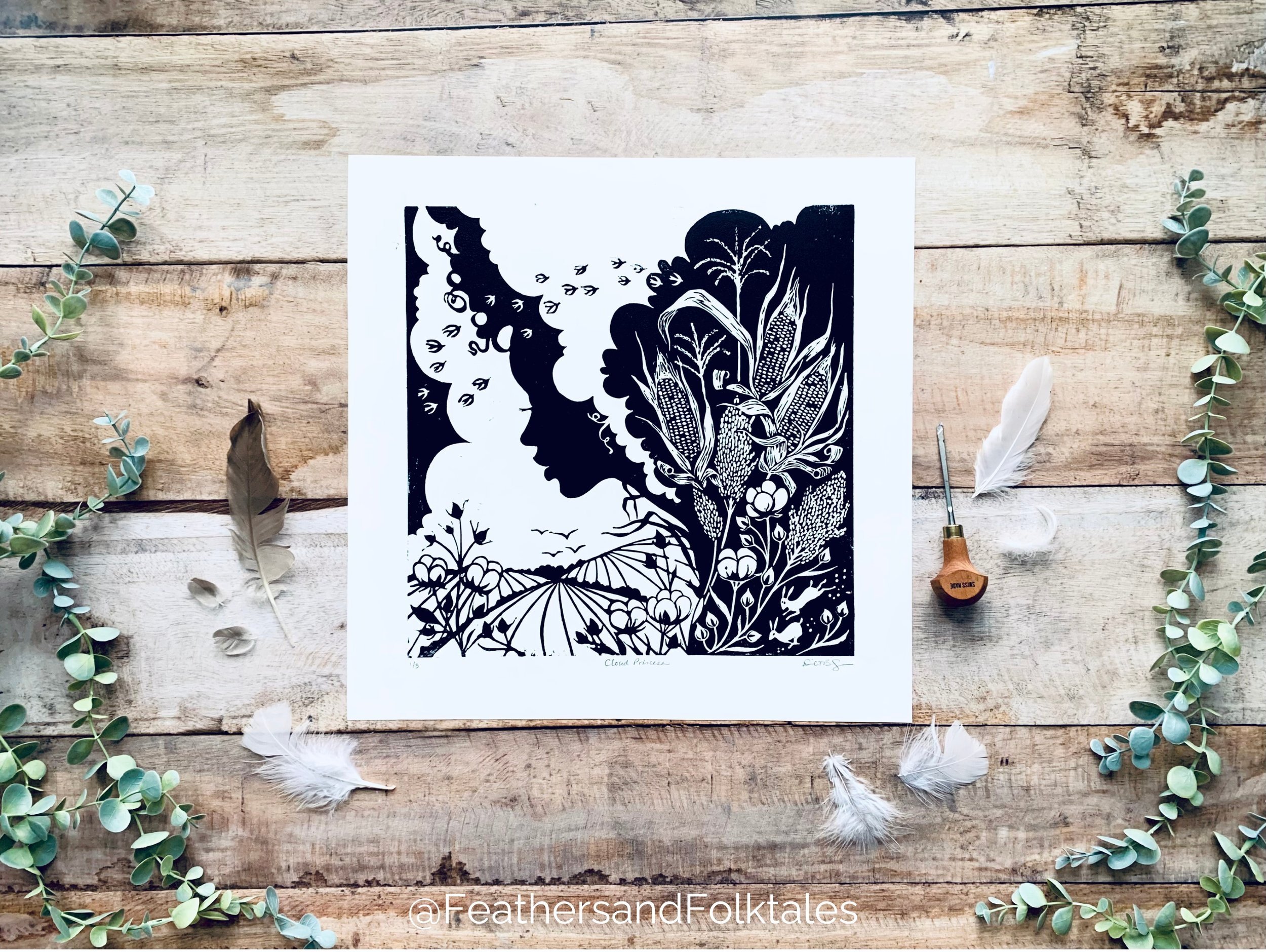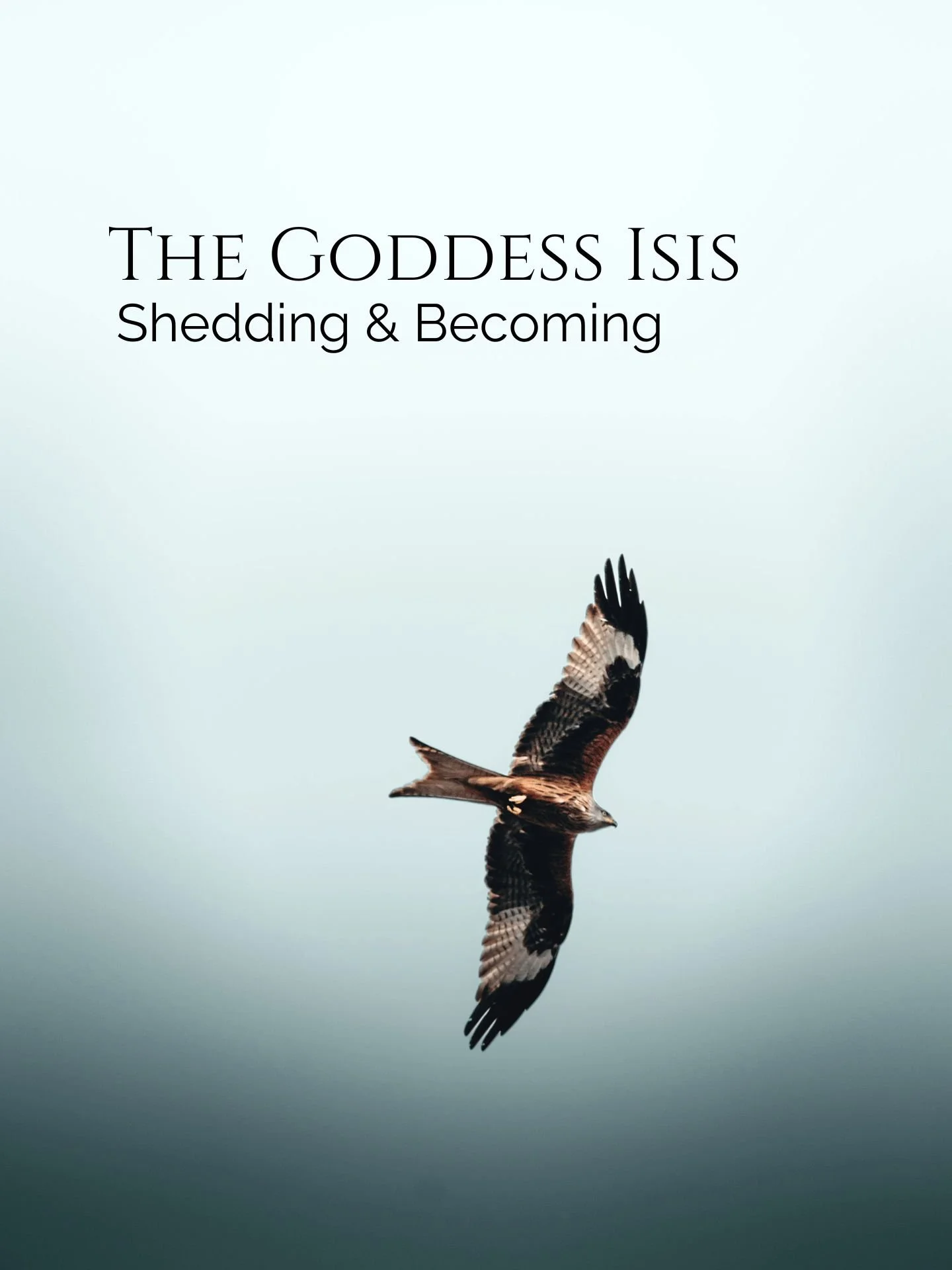Bridging continents and cultures, the Eswatini folktale of Cloud Princess from Africa and the Haudenosaunee folktale of Sky Woman from North America, offer us their shared and relevant wisdom enriching, deepening and expanding our understanding of the meaning of “generosity” in unexpected ways. We learn generosity is the vital and sacred choice that can weave us back into relationship with each other, draw us into closer kinship with the wild, and open ourselves up to belonging to a larger whole.
Cloud Princess is a heartwarming folktale featured in Kahran & Regis Bethencourt’s book Crowned: Magical Folk and Fairytales from the Diaspora (2023) and Nelson Mandela’s Favorite African Folktales (2002). It is a folktale about a Cloud who looks down at the earth and sees so much greed, but she notices one poor man who is generous in every way. One day he finds and takes care of a beautiful bird with a broken wing, when the wing is healed it transforms into a princess with white feathers. She tells him she is Cloud Princess and grants him one wish with one of her magic feathers. He silently makes his wish, but when he opens his eyes nothing has changed. In his disappointment he shares that he had hoped to be transformed into a handsome, rich and worthy Prince so he would win her heart. She responds he already has all the qualities she loves: kindness, generosity, and gentleness. Slowly through her eyes, the poor man is able to see himself in a new light: that his generosity makes him a Prince among men. They then wed, and from then on, are forever intertwined together.
I love how this ancient folktale is still relevant to our contemporary world where greed, consumerism and the pursuit of individual gain have become highly valued, and even sometimes regarded as necessary survival skills, during these times of turmoil and uncertainty. This folktale redeems and lifts up the act of generosity to its rightful place as a highly valued attribute, equal to or perhaps even more valuable than individual wealth accumulation. Robin Wall Kimmerer, renowned Potawatomi botanist, talks about this generosity in her recent book The Serviceberry: Abundance and Reciprocity in the Natural World (2024) where she contrasts the economic model of scarcity, competition and the pursuit of material gain with the indigenous gift economy approach which is rooted in reciprocity, interconnectedness, sense of abundance and gratitude. Kimmerer gives the example of the serviceberry tree’s generous offering of its berries to birds (who benefit from eating the fruit and then dispersing the seeds) as a way of ensuring its own survival. She says the serviceberry tree’s generosity towards others is a potential model for human economic and interpersonal relationships highlighting the mutual benefit of an economy centered around collaborative generosity and mutual flourishing rather than the accumulation of wealth for one’s own personal economic gain. Cloud Princess is similarly rewarding generosity, and in so doing, offering a very similar gift-economy wisdom.
Underlying this overt teaching is a deeper message about generosity if we weave in Kimmerer’s approach to thinking about generosity within ecosystems. Clouds not only offer water for the survival of all life, but they offer water generously to everyone regardless of our deeds and wrongdoings, our successes or failures, our brokenness or beauty, our wealth or poverty. “Generosity” seen in this light, is not selective, but openly offered like the serviceberries are to whoever picks and eats them. In a recent (December 24, 2024) Sounds of Sand Podcast, Pat McCabe & Francis Weller talk about what we can offer each other during this time of great upheaval and uncertainty and one of the offerings they identify is “Fearless Generosity” referring to a focus on collective benefit emphasizing the thriving of the whole. This “Fearless Generosity” is the spirit with which Cloud Princess and the serviceberry tree are doing their sacred work. Clouds rain on everyone and serviceberry trees offer their berries to everyone, both gift us with the same wisdom: generosity is about seeing the whole rather than just the individual parts.
This linocut print shows SkyWoman in my imagination filled with native North American wildflowers, herbs and plants including: California Poppy, Cattails, Echinacea, Elderberries, Maple seeds, Mesquite, Dandelion, Prickly Pear Cactus, Valerian, and Wild Rose. I made this print for those who wish to be reminded of SkyWoman and this gorgeous landscape called Turtle Island and the careful tending, reciprocity and belonging to each other that is required for Turtle Island to be sustained.
Though Cloud Princess may seem like a tale far away from where I live in North America, I can recognize Cloud Princess in Sky Woman, a North American folktale (indigenous Haudenosaunee creation story) about a Sky Goddess who falls from the sky bringing the first seeds to the earth retold beautifully in Kimmerer’s book Braiding Sweetgrass: Indigenous Wisdom, Scientific Knowledge and the Teachings of Plants. In this folktale, the geese, loons, and swans fly to catch Sky Woman’s fall, while otter, beaver and muskrat swim to the bottom of the ocean to find mud to cover turtle’s back to create a place for her to land. With gratitude for their generosity, she plants her seeds growing a lush landscape on Turtle’s back to feed and benefit everyone. I love how this Creation Story shows not only a fearless generosity on the part of the animals and Sky Woman in return, but how generosity is the first act that brings into being the world as we know it, and how it is generosity that ensures its continued thriving.
There is yet another more expansive way to think about generosity that we can learn from both these folktales combined. Both Cloud Princess and Sky Woman are folktales about the interaction and meeting of two very different worlds. Sky Woman is an outsider, an immigrant, a celestial stranger who falls from the sky into the world of earthly creatures, and through acts of reciprocation and generosity towards each other, Sky Woman and the earthly creatures weave themselves into relationship, and this generosity ensures that life thrives for the benefit of everyone on Turtle Island. Cloud Princess is, similarly, a folktale about bridging the unbridgeable distance between the human world and the more than human worlds. Through both their acts of generosity, Cloud Princess and the poor human farmer wed themselves and their worlds together. Cloud Woman and Sky Woman both show us it is through generosity that separate worlds can be woven together, and that through generosity we weave ourselves back into kinship with the wild. I find this particularly poignant and relevant today because it shows how generosity is not just an interpersonal tool to use between human-to-human, but a concept central to what Kimmerer refers to as “ecological economics”, a system of exchange mimicking circular economies of nature with an outcome that is more than just economic gain, it is a system that ensures the thriving of the planet and all creatures who live in it.
Though these folktales are from two different continents, and vastly different geographies, Cloud Princess and Sky Woman remind us of a shared wisdom centered around generosity and with this comes a sense of synchronicity and connection across the miles. Perhaps She is actually not two separate goddesses after all, but one Goddess - the Goddess - manifesting in different forms with different names, voiced in different languages. What else can this plurality be except generosity in its most potent form: the capacity to find belonging in multiple locations; the generous ability to resonate and harmonize Herself to suit the needs and understanding of people who are vastly different from each other; generously allowing us to connect with Her through a form that resonates with each of us personally. The Goddess shows us how to generously meet others where they are at, to give people the space to belong exactly where they are. Through manifesting in multiple forms, She shows us how to liberate ourselves from an imprisoning scripted concept of who we are versus who they are, and instead generously open ourselves up to seeing and finding ourselves in others.
Generosity defined in this way reminds me of a few lines from one of my favorite Rumi poems “The Breeze at Dawn”:
“The breeze at dawn has secrets to tell you.
Don’t go back to sleep.
You must ask for what you really want.
Don’t go back to sleep.
People are going back and forth across the doorsill where the two worlds touch.
The door is round and open.
Don’t go back to sleep”.
Here Rumi speaks of an open door between worlds with a threshold we can choose to freely cross. "Don't go back to sleep" is a call to remember the door exists, to become conscious of it, and a cautionary warning to not to fall back to sleep and forget it is even there. The Goddess also finds Her way through many landscapes to us through a door that is generously wide open, inviting and welcoming us generously to the other side. We too can find a larger sense of belonging to each other, to the wild, and to Her - by generously opening the doors we hold shut in our lives, and courageously venturing past its threshold.
Rumi’s open door poem reflects an ancient spiritual concept captured in the Heart Sutra*, the most frequently used and recited ancient spiritual text in the Mahayana Buddhist tradition widespread throughout Asia and Central Asia and now also the West. The Sanskrit word Sutra derives from the root siv meaning “to sew” referring to a “thread” that holds things together, like the English word suture. However some scholars have suggested that it might also come from sukta, meaning “wise saying”. . . Combining these together suggests there is wisdom in weaving things together, finding connections and relationships between things. The poetic passages of the Heart Sutra are centered around deconstructing all our usual conceptual frameworks, all our rigid ideas, all our belief systems, all our reference points, in order to draw our attention to the connectedness and interdependence of all things which comes with a deep reverence for remembering the whole. This is often translated as "emptiness" (shunyata) repeated throughout the sutra, referring to a vastness beyond limitations, which is why the sky is such an apt and brilliant metaphor that captures this idea. We all see the same sky above us, the clouds pass over disregarding all human-made borders gifting us their rain regardless of our origins, our cultures, our beliefs. The sky reminds us of our connectedness and how we are all sheltered beneath the generous arched curves of this cathedral of emptiness.
We can find Goddesses of the Sky scattered throughout the world, not just Sky Woman and Cloud Princess but also: Eos, an Ancient Greek Goddess who is drawn across the sky by a chariot of winged horses bringing in the dawn; or the Albanian equivalent, Prende, who is pulled across the sky in a chariot by swallows bringing in the dawn; Nut, the ancient Egyptian sky goddess arching over the Earth dressed in a cloak of stars; or Isis, a winged goddess associated with kites and falcons searching from her place in the sky for the scattered remains of her husband Osiris’ body; Aditi, the Hindu goddess of the infinite and vast cosmos, as well as motherhood, consciousness, unconsciousness and more. The list is endless. . . . Can we consider the presence of the Goddess in her multiple Sky forms as a sign that She is inviting us to be generous too, and that we too can do the sacred work of crossing the threshold of the doors between us and weave ourselves together again?
Sky Woman and Cloud Princess in my imagination, peering at each other’s worlds. . .or perhaps peering at their reflection through a looking glass. . .a door that is wide open.
Note* For an English translation of the Heart Sutra, here is Thich Nhat Hanh’s version.
References:
Benazzo, Maya & Maurizio. Sounds of Sand. Episode #113 “Ancient Rhythms: Pat McCabe & Francis Weller” (December 24, 2024). Apple Podcast..
Bethencourt, Kahran & Regis (2023). Crowned: Magical Folk and Fairytales from the Diaspora. which includes classic well known fairytales as well as fairytales from the African diaspora and from the African continent. St Martin’s Press.
Kimmerer, Robin Wall (2014). Braiding Sweetgrass: Indigenous Wisdom, Scientific Knowledge and the Teachings of Plants. Minneapolis: Milkweed Editions.
Kimmerer, Robin Wall (2024). The Serviceberry: Abundance and Reciprocity in the Natural World. Scribner.
Mandela, Nelson (2002). Favorite African Folktales. W. W. Norton & Company.
Toko-pa (2017). Belonging: Remembering Ourselves Home. Her Own Room Press.














The Celtic Morrigan, Slavic Morana, and Hindu Dhumavati are entwined through the dark wings of the raven. Their aerial point of view gifts them with wisdom to see the whole. Witch and winged-one in sacred kinship, they remind us that even in collapse, something wild and wise takes root. Their black feathers stitching together life and death, winged and earthbound, mortal and divine, seen and unseen. . .